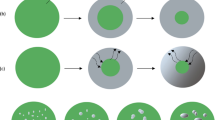Abstract
A detailed CCSD(T)//B3LYP study is presented to unravel the gas-phase reductive hydrogenation process of dioxides MO2 (M = Si, Ti, Zr, Sn, Hf, Ir Ce) according to the following reaction MO2 + H2 → M(OH)2. For the reductive hydrogenation process, a heterolytic H–H bond cleavage is considered via hydride intermediates OMH(OH). A discussion concerning the effects of the reducibility of the metal centers and the structural aspects of the dioxides is presented. The results show that the activation of molecular hydrogen is directly related to the capability of the oxide to polarize the H2 molecule prior to the H–H bond cleavage, although the formation of hydride intermediates does not necessarily guarantee further reduction of the metal center. The activation of the reduction reaction to form M(OH)2 is found to be significantly larger than the activation to form the OMH(OH) intermediate. This gas-phase study aims to enhance the fundamental understanding of elementary steps in reductive hydrogenation processes of metal oxides.









Similar content being viewed by others
References
Li YW, Hou C, Jiang JX, Zhang ZH, Zhao CY, Page AJ, Ke ZF (2016) ACS Catal 6:1655–1662
Satyapal S, Petrovic J, Read C, Thomas G, Ordaz G (2007) Catal Today 120:246–256
Hamilton CW, Baker RT, Staubitz A, Manners I (2009) Chem Soc Rev 38:279–293
Clapham SE, Hadzovic A, Morris RH (2004) Coord Chem Rev 248:2201–2237
Keaton RJ, Blacquiere JM, Baker RT (2007) J Am Chem Soc 129:1844–1845
Sattler A, Parkin G (2011) J Am Chem Soc 133:3748–3751
Suresh C, Santhanaraj D, Gurulakshmi M, Deepa G, Seivaraj M, Rekha NRS, Shanthi K (2012) ACS Catal 2:127–134
Berke H (2010) ChemPhysChem 11:1837–1849
Kubas GJ (2009) J Organomet Chem 694:2648–2653
Kubas GJ (2001) Metal-dihydrogen and σ-bond complexes: structure, theory, and reactivity. Kluwer Academic, New York
Gonzalez-Navarrete P, Calatayud M, Andres J, Ruiperez F, Roca-Sanjuan D (2013) J Phys Chem A 117:5354–5364
Kubas GJ (2007) Chem Rev 107:4152–4205
Nishimura S (2001) Handbook of heterogeneous catalytic hydrogenation for organic synthesis. Wiley, New York
Vries Jgd, Elsevier CJ (2007) The handbook of homogeneous hydrogenation. Wiley, Weinheim (Great Britain)
Centi G, Wichterlová B, Bell AT (2001) Catalysis by unique metal ion structures in solid matrices: from science to application. Kluwer Academic, Dordrecht
Thomas JM, Thomas WJ (1997) Principles and practice of heterogeneous catalysis. VCH, Weinheim
Schlangen M, Schwarz H (2012) Catal Lett 142:1265–1278
Bohme DK, Schwarz H (2005) Angew Chem Int Ed 44:2336–2354
Vajda S, White MG (2015) ACS Catal 5:7152–7176
Yin S, Bernstein ER (2014) Phys Chem Chem Phys 16:13900–13908
Sun XY, Zhou SD, Schlangen M, Schwarz H (2016) Angew Chem Int Ed 55:13345–13348
Frisch M, Trucks G, Schlegel H, Scuseria G, Robb M, Cheeseman J, Scalmani G, Barone V, Mennucci B, Petersson G (2009) Gaussian 09, revision D. 01. Gaussian Inc., Wallingford
Becke AD (1993) J Chem Phys 98:5648–5652
Lee CT, Yang WT, Parr RG (1988) Phys Rev B 37:785–789
Weigend F, Ahlrichs R (2005) Phys Chem Chem Phys 7:3297–3305
Andrae D, Haussermann U, Dolg M, Stoll H, Preuss H (1990) Theor Chim Acta 77:123–141
Metz B, Stoll H, Dolg M (2000) J Chem Phys 113:2563–2569
Dolg M, Stoll H, Preuss H (1989) J Chem Phys 90:1730–1734
Rappoport D, Furche F (2010) J Chem Phys 133:134105
Syzgantseva OA, Calatayud M, Minot C (2012) J Phys Chem C 116:6636–6644
Barteau MA (1996) Chem Rev 96:1413–1430
Calatayud M, Markovits A, Menetrey M, Mguig B, Minot C (2003) Catal Today 85:125–143
Matz O, Calatayud M (2018) ACS Omega 3:16063–16073
Garcia-Melchor M, Lopez N (2014) J Phys Chem C 118:10921–10926
Fernandez-Torre D, Carrasco J, Ganduglia-Pirovano MV, Perez R (2014) J Chem Phys 141:014703
Vecchietti J, Baltanas MA, Gervais C, Collins SE, Blanco G, Matz O, Calatayud M, Bonivardi A (2017) J Catal 345:258–269
Syzgantseva O, Calatayud M, Minot C (2011) Chem Phys Lett 503:12–17
Helali Z, Jedidi A, Syzgantseva OA, Calatayud M, Minot C (2017) Theor Chem Acc 136:100
Karvembu R, Prabhakaran R, Natarajan K (2005) Coord Chem Rev 249:911–918
Blum Y, Czarkie D, Rahamim Y, Shvo Y (1985) Organometallics 4:1459–1461
Kuzu I, Krummenacher I, Meyer J, Armbruster F, Breher F (2008) Dalton Tran 5836–5865
Acknowledgements
This work was performed using HPC resources from GENCI- CINES/IDRIS (Grants 2018- x2018082131, 2019- x2019082131) and the CCRE-DSI of Université P. M. Curie. The authors are grateful to Sorbonne Université for the PER-SU iDROGEN project.
Author information
Authors and Affiliations
Corresponding author
Additional information
Publisher's Note
Springer Nature remains neutral with regard to jurisdictional claims in published maps and institutional affiliations.
Published as part of the special collection of articles derived from the 11th Congress on Electronic Structure: Principles and Applications (ESPA-2018).
Electronic supplementary material
Below is the link to the electronic supplementary material.
Rights and permissions
About this article
Cite this article
González-Navarrete, P., Calatayud, M. On the reductive hydrogenation process of gas-phase metal dioxides: H2 activation or reduction of the metal center, what is more important?. Theor Chem Acc 138, 98 (2019). https://doi.org/10.1007/s00214-019-2482-6
Received:
Accepted:
Published:
DOI: https://doi.org/10.1007/s00214-019-2482-6




